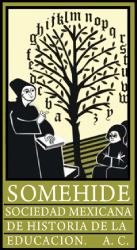Fiscal reforms and community cash schools. The school of the Chucándiro sub-delegation of the Valladolid of Michoacán municipality, 1790-1802
DOI:
https://doi.org/10.29351/amhe.v3i1.471Keywords:
Schools, finances, community cashAbstract
The present study is one more of this author, on the installation and operation of the community cashier schools of the Municipality of Valladolid de Michoacán, a new testimony of the educational reform of the Bourbon regime at the end of the 18th century; example of how the application of Enlightenment thought was manifested in the educational field. The work focuses on the finances and the school of the sub-delegation of Chucándiro, head of the sub-delegation of the same name. It is located very close to the ancient city of Valladolid, today Morelia, just 5 leagues from it (Cedeño, 1990, p. 19) —between 22.5 and 25 kilometers—. The settlement already existed in pre-Hispanic times, and although it is not the only one, the towns that surround it are not indigenous, so it is the only one reported in the jurisdiction, and in the list of community cashier schools of Indian towns. Because when the Bourbon regime applied its reforms to the indigenous communities in the second half of the 18th century; the one exercised on its finances, began with the regulation of the community funds of these towns, which established a public financing that covered; precisely, the resources of these localities. This is an analysis of what happened with the Chucandiro school, in direct relation to the resources generated by the organization of the natives through their own resources, as well as the expenses that they had to incur, according to the regulations that were imposed on them. The located documentation allows us to analyze and reflect on the 13-year period from 1790 to 1802.
References
AGN [Archivo General de la Nación] (s.f.a). Ayuntamiento [vol. 220, exp. 1, Zinapécuaro]. Ciudad de México.
AGN (s.f.b). Ayuntamiento [vol. 220, exp. 2, Cuiseo de la Laguna]. Ciudad de México.
Bustamante Vismara, J. (2012). La contribución directa y las escuelas elementales en el valle de Toluca, 1820-1874. Relaciones. Estudios de Historia y Sociedad, 33(132bis), http://www.scielo.org.mx/scielo.php?script=sci_arttext&pid=S0185-39292012000500007
Cajas de la Real Hacienda de la América Española, siglos XVI a principios del siglo XIX (s.f.). Ingresos y egresos de la Real Hacienda de Nueva España. https://realhacienda.colmex.mx/introduccion-ingresos-y-egresos-de-la-real-hacienda-de-nueva-espana/
Cedeño Peguero, M. G. (1990). El general Epitacio Huerta y su Hacienda de Chucándiro 1860-1892. Instituto Michoacano de Cultura.
Cedeño Peguero, M. G. (2018). Historia y educación. La educación elemental en el Michoacán virreinal. De las escuelas de doctrina a las de caja de comunidad, siglo XVI al XVIII. Universidad Michoacana.
De Alcalá, F. J. (s.f.). La relación de Michoacán, México [colec. Cien de México]. Secretaría de Educación Pública.
Florescano, E. (1989). Historia general de Michoacán [vol. 1]. Gobierno del Estado de Michoacán.
García Martínez, B. (2022). El tributo en Nueva España. https://arqueologiamexicana.mx/mexico-antiguo/el-tributo-en-nueva-espana
Mendoza García, E. (2018). Crecimiento económico de las cajas de comunidad en la jurisdicción de Otumba, siglo XVIII. Estudios de Historia Novohispana, (58). http://dx.doi.org/10.22201/iih.24486922e.2018.58.63063
Nava Oteo, G. (1971). Cajas de Bienes de Comunidades Indígenas. Anales del Museo Nacional de México, (2), 349-359. https://dialnet.unirioja.es/servlet/articulo?codigo=2887657
Pietschmann, H. (2016). Las reformas fiscales novohispanas del siglo XVIII, en sus dimensiones históricas múltiples. Tempus Revista en Historia General Medellín, (4), 205-238.
Tanck de Estrada, D. (1999). Pueblos de indios y educación en el México Colonial, 1750-1821. El Colegio de México.
Terán, M. (1994). Reflexiones sobre las reformas borbónicas en los pueblos de indios (y vecindarios) michoacanos 1790-1810. En C. Paredes Martínez (coord.), Lengua y etnohistoria purépecha. Homenaje a Benedict Warren (pp. 333-357). Universidad Michoacana/Centro de Investigaciones y Estudios Superiores en Antropología Social.
Terán, M. (1999). La relación de las cajas de comunidad de los pueblos indígenas michoacanos con la Real Hacienda entre 1779-1810. En B. Skinfill Nogal y A. Carrillo Cázares (coords.), Estudios michoacanos VIII. El Colegio de Michoacán.
Uriarte, M. del C. (2010). El Hospital de San Lázaro de la ciudad de México y los leprosos novohispanos durante la segunda mitad del siglo XVI. EHN, (42), 81-113. http://www.ejournal.unam.mx/ehn/ehn42/EHN000004203.pdf
Downloads
Published
How to Cite
Issue
Section
License
Todos los contenidos del Anuario Mexicano de Historia de la Educación se publican bajo una licencia Creative Commons Atribución No Comercial 4.0 Internacional (CC BY-NC 4.0), que permite compartir (copiar y redistribuir el material en cualquier medio o formato) y adaptar (remezclar, transformar y construir a partir del material) para fines no comerciales, dando los créditos a los autores y a la revista, tal como lo establece la licencia.
La política de acceso abierto y de licencias con “algunos derechos reservados” no niega la propiedad intelectual ni los derechos de los autores respecto a sus artículos, pues ellos son los titulares, en tanto que el Anuario Mexicano de Historia de la Educación no los reserva para sí ni para la institución editora, ya que se apegan a movimientos de acceso abierto como los Principios y Valores del Sistema de Información Científica Redalyc - Red de Revistas Científicas de América Latina y el Caribe, que pugnan por la eliminación de las políticas de embargo para que el autor retenga los derechos de su obra (principio número 8). Así como las políticas de acceso abierto del Directory of Open Access Journals (DOAJ).
Los autores podrán distribuir su propio material en cualquier otro medio o soporte, siempre y cuando sea para fines no comerciales, informando a los editores que el trabajo será publicado nuevamente y dando el crédito correspondiente al Anuario Mexicano de Historia de la Educación.
La publicación en el Anuario Mexicano de Historia de la Educación, por su carácter gratuito, no da derecho a remuneración económica alguna a los autores, ni a los dictaminadores.
Los lectores podrán reproducir (copiar), comunicar, distribuir o hacer obras derivadas de los artículos o colaboraciones publicados en el Anuario Mexicano de Historia de la Educación en los siguientes casos:
- Para fines públicos.
- Sin fines comerciales.
- Que se reconozca la autoría de la obra y se cite su origen con información completa: Apellido/s del autor, inicial/es del nombre/s. (año de publicación). Título del artículo. Nombre de la revista, volumen (número de ejemplar), página inicial del artículo-página final del artículo. DOI o URL (formato sugerido de acuerdo al estilo APA en su versión más reciente).
El cuerpo editorial del Anuario Mexicano de Historia de la Educación asumirá el compromiso de notificar oportunamente a los autores sobre cualquier cambio de ubicación de los artículos en el sitio (cambio de dirección URL o de conexiones para identificar el artículo).
Los autores, al enviar sus trabajos para su posible publicación, deberán tomar en cuenta los puntos anteriores, mismos que se contemplan en el Acuerdo entre autor y el Anuario Mexicano de Historia de la Educación.












